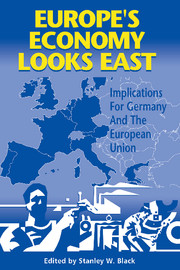Book contents
- Frontmatter
- Contents
- List of figures and tables
- Preface
- List of conference participants
- List of acronyms
- 1 Introduction
- I Trade relations
- II Investment patterns
- 5 Investment and its financing during the transition in Central and Eastern Europe
- Comments
- 6 Privatization, structural change, and productivity; toward convergence in Europe?
- Comments
- III Labor market issues
- IV The process of integration
- Index
Comments
Published online by Cambridge University Press: 03 February 2010
- Frontmatter
- Contents
- List of figures and tables
- Preface
- List of conference participants
- List of acronyms
- 1 Introduction
- I Trade relations
- II Investment patterns
- 5 Investment and its financing during the transition in Central and Eastern Europe
- Comments
- 6 Privatization, structural change, and productivity; toward convergence in Europe?
- Comments
- III Labor market issues
- IV The process of integration
- Index
Summary
The paper by Stanley Black and Mathias Moersch is an adventurous and readable effort to bring some orthodox economic analysis to bear on what is clearly a major structural and hence nonmarginal adjustment problem – moreover, a structural adjustment that is considered as taking place over a relatively short time scale. For this discussant, reading the paper induced a distinct air of nostalgia since as a then civil servant in the UK, it reminded me of official and other debates concerning the British Labour Government's National Plan of the mid-1960s, when what now seem to be long lost expressions such as “investment requirements” and “incremental capital/output ratios, or ICORs” and the like readily tripped off the tongue. I find myself, therefore, in a kind of time warp but one which is nonetheless interesting for that. On this occasion, Rip Van Winkle has awakened to find that not much has changed!
The basic starting point of the paper is to examine what the feasible sources of capital accumulation are likely to be and then see what in principle can be achieved with these resources. As the paper notes, this is in contrast to the more typical approach, which is to choose a target level, or growth rate for real output, translate this into an investment requirement, and then make some inferences about what is implied for the supply of savings.
- Type
- Chapter
- Information
- Europe's Economy Looks EastImplications for Germany and the European Union, pp. 201 - 211Publisher: Cambridge University PressPrint publication year: 1997



